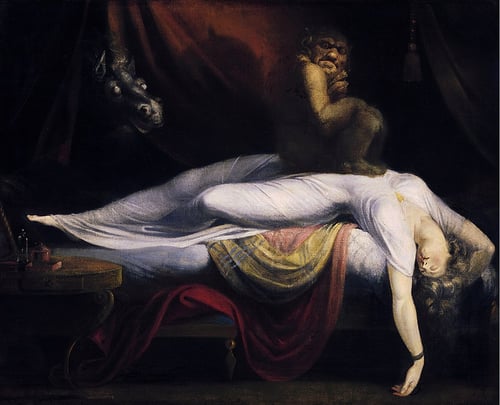Most Common Parasomnias
Parasomnias relate to several different sleep disorders. They affect the ability to sleep, disrupt your circadian rhythm, and lead to sleep deprivation. Some parasomnias will be obvious and easy to identify, others will require a bed partner to identify.
The most common parasomnias are:
- Sleep terrors
- Sleep talking
- Sleepwalking
- Sleep paralysis
- REM sleep behavior disorder
- Catathrenia
As we explore this list, take note of any of these parasomnias that resonate with you.
Overview of Sleep Terrors
Sleep terrors, also known as night terrors, are when you partially rouse or fully wake up from sleep in a confused, terrified state, but are unable to articulate why. While this can be disconcerting for the sleeper to wake up this way, it can be particularly scary for the parent or bed partner witnessing the sleep terror.
People who awake from sleep terrors often do not respond to voices, and it can be hard to fully wake them. Some things to be aware of sleep terrors are:
- Night terrors are like nightmares, but unlike nightmares they occur in deep sleep and may have a larger affect
- They are common in kids than adults
- Terrors usually last about 15 minutes
- After a sleep terror, the sleeper may fully rouse or go back to sleep
- Sleepers do not remember their night terror upon waking
If someone is experiencing a night terror, it’s best to remain calm and to try and wake them gently, as they may be agitated, confused, and scared.
Overview of Sleep Talking
Sleep talking is talking in your sleep and can include:
- Brief simple sounds, to
- Single words and mumbling, to
- Long speeches by the sleeper
Most people will make brief, simple sounds, or you may be able to distinguish particular words. It’s less common, though not uncommon, for people to say whole sentences or even give long speeches. Sleep talkers will usually have no memory of their talking in the morning.
Though sleep talking is not disruptive for the sleeper, it can be disruptive for the sleep partner.
Overview of Sleepwalking
Similar to sleep talking is sleepwalking. Sleepwalking is when you appear to be awake and move around, but you are sleeping. Here is pertinent information about sleepwalking:
- It usually occurs during non-REM sleep (stages three and four)
- It often occurs early in the night and can occur during REM sleep early in the morning
- Most commonly seen in children between 5 and 12 years old
- Sleepwalkers have no memory of their sleepwalking in the morning
- Sleepwalkers may travel far (like, into the neighbor’s house)
- Sleepwalkers may do extremely abnormal things like, as one sleepwalker told us, go pee in the dishwasher because they thought it was the toilet
- Sleepwalking can be dangerous, as sleepwalkers do not have a good understanding of their surroundings and are prone to hurting themselves
Like sleep terrors, if someone is sleepwalking it’s best to remain calm and to try and wake them gently because they may become agitated and confused.
Overview of Sleep Paralysis
Sleep paralysis is exactly what it sounds like - an inability to move your body or limbs – and occurs as you are falling asleep or waking up. These episodes can last anywhere from a few seconds to upwards of a couple of minutes. It can be quite scary for the person who is experiencing the episode.
 The Nightmare is thought to be a depiction of sleep paralysis perceived as a demonic visitation.
The Nightmare is thought to be a depiction of sleep paralysis perceived as a demonic visitation.
The causes of sleep paralysis are not known, though it seems to run in families. It can be chronic, or only happen once.
Overview of Catathrenia
Catathrenia is a sleep disorder that involves breath-holding and expiratory groaning during sleep. It is not the same as obstructive sleep apnea (OSA) or somniloquy (sleep talking). The sound is produced during exhalation after holding the breath, whereas OSA is produced by airway obstruction snoring during inhalation.
The primary symptom is a bed partner noticing the sleeper take a deep breath, hold it, and then exhale slowly. Often this exhale is accompanied by a high-pitched squeak or groaning. This sound may rouse the sleeper throughout the night, leading to sleep deprivation.
Overview of REM Sleep Behavior Disorder (RBD)
REM sleep behavior disorder occurs mostly in men over 50 years old, though it can occur in women and younger people as well.
RBD is a sleep disorder where you act out dramatic or violent dreams, such as by moving your body or limbs while dreaming. Unlike sleepwalking and sleep terrors where you don’t remember the episode in the morning, RBD dreams can usually be recalled by sleepers upon waking.
RBD can be a symptom of potentially serious neurological disorders, so if you are potentially experiencing RBD you should seek medical attention right away. Sleep studies will be used to rule out or diagnose RBD.
If any of the above sleep disorders resonated with you, then there may be an underlying sleep disorder preventing you from getting a good night's sleep. Please click the orange button below to take a free online sleep test and talk with one of our sleep health professionals.


